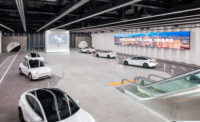Worries about recessions and resources have done little to dampen the Las Vegas area construction market, and few specialty contractors better illustrate the current run of robustness than Commercial Roofers Inc. (CRI), ENR Southwest Specialty Contractor of the Year.
The firm reported nearly $56 million in regional revenue in 2022, a nearly 82% increase over the previous year. Its crews could be found topping off high-profile projects across the valley, including a $2.7-million contract for the IMC World Market Center Building A project in Las Vegas, which completed construction last year; the $2.3-billion MSG Sphere at the Venetian Resort; and the 300,000-sq-ft paddock building for the Formula 1 Heineken Silver Las Vegas Grand Prix this fall. Appropriately, CRI is also playing a role in getting the long-delayed, multibillion Fontainebleau Las Vegas hotel and casino to its scheduled December 2023 finish.

Commercial Roofers played an important role on the $2.7-billion MSG Sphere (far left) project in Las Vegas.
Photo courtesy Commercial Roofers Inc.
“Coming out of COVID, everyone wanted to vent, so they all came to Las Vegas,” observes John McGeary, company vice president and chief operating officer. With requests for roofing bids and proposals for new construction over the past two years tripling the number issued to the firm in 2021, he adds, “We’re still seeing the positive effects of that demand.”
McGeary credits the company’s successful navigation of economic uncertainties as well as technical and business fundamentals set in place by co-founders and industry veterans Scott Howard and Dennis Conway in 1998, followed by 25 years of work to build a 95% repeat customer rate. Simply put, McGeary adds, “We do what we say we’re going to do, including difficult projects that have hard deadlines. General contractors recognize a company that can get things done, and we’re fortunate that many of those qualities came to light in 2022.”
Operations manager David Ramos notes that CRI made the most of the pandemic-driven 2020 slowdown, implementing a robust training program for its staff and stockpiling available materials while also focusing on still active projects such as the $1-billion Las Vegas Convention Center Expansion, which is on schedule with more than 1.1 million sq ft of single-ply membrane roofing.
“We maintained our staff and our focus because we knew we were going to get out of this,” Ramos recalls. “When clients began to call us again, we were ready.”

Charlee Sadahiro, project superintendent for Commercial Roofers, is overseeing the company's work at the 67-story Fontainebleau project.
Photo courtesy Commercial Roofers Inc.
Grief and Going Forward
Just as the Las Vegas construction market seemed to be stabilizing in late 2020, the company’s business and organizational fundamentals were again challenged when Scott Howard, who with his wife, Janet, had assumed sole ownership the previous year, died following a battle with cancer.
Having been part of CRI’s leadership for more than two decades, Janet Howard was no stranger to the company or to the roofing industry when she stepped into the role of president and CEO. She also had the advantage of an experienced, supportive staff and the counsel of former owner Conway.
“Functionally, we focused on processes and procedures and revisited the basic blocking and tackling that Scott had put in place for all those years,” Ramos recalls. “We made sure everyone understood roles and responsibilities, but also listened to their thoughts and concerns about where the company was going.”
“The senior project managers are like a walking book for me to explore and learn from. I give them all the credit for just keeping our company going.”
—Janet Howard, President & CEO, Commercial Roofers Inc.
Janet Howard calls the experience of the past three years “an amazing journey,” one that has given her an even deeper appreciation of CRI’s depth and breadth of experience.
“The senior project managers are like a walking book for me to continue to explore and learn from,” she says. “I give them all the credit for just keeping our company going.”
Lindsay Jacobs, the daughter of Scott and Janet Howard and the manager of CRI strategic accounts, agrees. “Dad always said we had the best people working for us, and that it wasn’t by accident,” she says. “You can’t buy the hundreds of years of experience within our company.”
A milestone in the firm’s organizational transition was completed earlier this year with its official certification as both a Women’s Business Enterprise by the Women’s Business Enterprise National Council and a Minority Business Enterprise by the National Minority Supplier Development Council.
“Everyone on staff rallied to support Janet through the process, and it’s something the general contractors are excited about,” Jacobs says. “It’s opened doors and created opportunity in the community.”
Diversifying the workforce is a commitment that predates Janet Howard’s CEO role. With nine women roofers on staff, the company employs more than two-thirds of the women members of United Union of Roofers, Waterproofers and Allied Workers, Local 162. CRI’s women leaders have also represented the company and industry at various national-level programs.
Safety is another priority for the firm, which touts an EMR of 0.65. In addition to a standing employer-employee safety committee that monitors and evaluates safety program effectiveness, the company provides free monthly inspections of each roofer’s personal fall-arrest system. Semi-annual safety fairs that are mandatory for all field employees provide opportunities to experience different jobsite safety scenarios and training stations.
Ramos says such strong employee buy-in and participation “mitigates and controls risk for us, and for our clients. That mentality and approach is what makes it successful.”

Contractors who have worked with Commercial Roofers note the "family atmosphere" of its staffers, pictured here at a recent company BBQ.
Photo courtesy Commercial Roofers Inc.
Services and Skills
Over the years, CRI has developed other resources to benefit its customers, including an onsite metal shop that lowers costs on metal work scopes, particularly for complex projects. John Bale, a project manager at Sletten Construction, says that capability helps CRI improve on architects’ specifications and reduce costs.
“They’re great about working with us in design-build projects, coming up with systems that meet our budget,” adds Bale, whose experiences with CRI include the four-year, $99.5-million renovation of the Clark County Detention Center. The company “shows up with the right number of workers and gets the job done. I’m picking up time in the roofing phase because they work faster than allotted.”
CRI also has strived to keep pace with increasing demand for more sustainable, energy-saving roofing system options.
“The family atmosphere extends through everything they do. The door is always open.”
—Michael Sukeyasu, Project Manager, M.J. Dean Construction
“Requests for asphalt and black rubber roofs have all but disappeared, with white reflective roofs becoming the standard,” says project manager Sean Howard, Scott and Janet’s son. “Mounts for rooftop solar panels have also been requested increasingly in the last couple of years as costs for photovoltaic systems continue to drop.”
Perhaps the most important resources the contractor offers are the experience and innovation necessary to tackle projects that require more than a conventional flat roof.
For the MSG Sphere, a 366-ft-high, 516-ft-wide multipurpose entertainment venue, the company developed a strategy to install a 180,000-sq-ft spray-foam roofing system with a coating overtop. It is designed to reduce waste and eliminate structural loading issues associated with the originally planned single-ply roofing system.
Working from five 30-ft to 40-ft-long modified swing-stage platform carriages, CRI crews overcame the dome structure’s challenging 8:12 pitch and safely built up the 5-in.-thick foam layer and top coat. Once the dome’s circumference was completed, workers moved to the top where they were able to stand while being tied off in case of a fall.
“A lot of thinking and planning went into that strategy, which was a true reflection of the project management team and the field experience,” says Michael Sukeyasu, project manager for M.J. Dean Construction Inc., which served as a construction consultant to the owner. “It was a matter of coming together and saying ‘How can we do this’ rather than ‘Can we do this?’ I think we exhausted everything [CRI] has to offer as far as services and skills.”
While MSG Sphere was Sukeyasu’s first project with the company, he was familiar with its long-standing reputation of industry and community involvement, which includes continuing Scott Howard’s support for the School of Architecture at the University of Nevada, Las Vegas.
In addition to funding an annual scholarship, CRI donates materials for use in the school’s Solar Decathlon and provides guest lecturers to share insights on roofing systems. The company is also an active supporter of Rebuild Together Southern Nevada, the Clark County School District and Construction vs Cancer Las Vegas.
“The family atmosphere of the company extends through everything they do,” Sukeyasu says. “The communication is great, and the door is always open, which is testament to Scott’s legacy."

The recently completed expansion of the Las Vegas Convention Center marked the largest contract in Commercial Roofers' history.
Photo courtesy Commercial Roofers Inc.
Onward and Upward
Although predictions of a recession may still materialize, McGeary is confident that the company’s near-term position is sound, particularly since it has been working to diversify its customer base within the health care and public sectors.
“Our backlog is pretty robust, with projects sold into next year and going into 2025 as well,” he says.
Jacobs adds that southern Nevada political and business leaders have taken a similar approach to attract a broader range of businesses to the area.
“After the 2009 recession and COVID, we saw risks of putting all our eggs in the entertainment industry,” she says. “There are lots of different aspects that will continue to produce a thriving economy for our city— and they all need roofs.”





Post a comment to this article
Report Abusive Comment